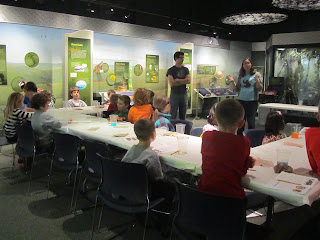 After
the races subsist and pizza and juice devoured in Bird Hall, the children begin
the first dinosaur related activity – becoming miniature paleontologists. We
take a moment to talk about what a paleontologist does: they dig up prehistoric
animals, like fossils or woolly mammoths, out in the field, then study them in
their labs. Most of all, we talk about why a paleontologist does their job: why
dig up old animals when there’s so much new to explore? Why take the time to
carefully retrieve the bones from the wild, clean them off with care, run tests
on them and make models for museums?
After
the races subsist and pizza and juice devoured in Bird Hall, the children begin
the first dinosaur related activity – becoming miniature paleontologists. We
take a moment to talk about what a paleontologist does: they dig up prehistoric
animals, like fossils or woolly mammoths, out in the field, then study them in
their labs. Most of all, we talk about why a paleontologist does their job: why
dig up old animals when there’s so much new to explore? Why take the time to
carefully retrieve the bones from the wild, clean them off with care, run tests
on them and make models for museums?  Each
child gets a plate covered in sand and fossils – they have to use a plastic
spoon to carefully retrieve their fossil from the sand. Some children dig right
in, pounding the sand to try and find their fossil, but others, in true
paleontologist form, take more time, scraping past the layers of dust to come
up with a dinosaur head (albeit plastic).
Like real paleontologists, they want to know what kind of dinosaur they
have – sure, the dinosaurs have been in the sand (although only for a day or
two, not millions of years), but that doesn’t mean the children can’t learn
from them. Real bones found in the wild,
and even their plastic counterparts, have much to tell us about an Earth that’s
radically different from today. We’ll never get to see it in our lifetimes, but
we can always make a good guess, which is what paleontology is about.
Each
child gets a plate covered in sand and fossils – they have to use a plastic
spoon to carefully retrieve their fossil from the sand. Some children dig right
in, pounding the sand to try and find their fossil, but others, in true
paleontologist form, take more time, scraping past the layers of dust to come
up with a dinosaur head (albeit plastic).
Like real paleontologists, they want to know what kind of dinosaur they
have – sure, the dinosaurs have been in the sand (although only for a day or
two, not millions of years), but that doesn’t mean the children can’t learn
from them. Real bones found in the wild,
and even their plastic counterparts, have much to tell us about an Earth that’s
radically different from today. We’ll never get to see it in our lifetimes, but
we can always make a good guess, which is what paleontology is about. Later on
– after trips through Bird and Mammal Hall, as per tradition – the children come
back to the discovery hub to try their hand at fashioning their own
dinosaurs. The floor covered in all
kinds of craft materials, from pipe cleaners to plastic jewels to paper and
scissors, the children grab everything they can in a minute and then set to
fashioning their own dinosaurs. Some of
them are crafty; others aim for a basic dinosaur that can “get the job done.”
All of them twist their pipecleaners and add their clothespins, trying to make
the best dinosaurs possible. (Children
are infinitely better at these kinds of things – my dinosaur is only a dinosaur
if you tilt your head to the left and squint; my dinosaur will not be roaming
the wild anytime soon.)
Later on
– after trips through Bird and Mammal Hall, as per tradition – the children come
back to the discovery hub to try their hand at fashioning their own
dinosaurs. The floor covered in all
kinds of craft materials, from pipe cleaners to plastic jewels to paper and
scissors, the children grab everything they can in a minute and then set to
fashioning their own dinosaurs. Some of
them are crafty; others aim for a basic dinosaur that can “get the job done.”
All of them twist their pipecleaners and add their clothespins, trying to make
the best dinosaurs possible. (Children
are infinitely better at these kinds of things – my dinosaur is only a dinosaur
if you tilt your head to the left and squint; my dinosaur will not be roaming
the wild anytime soon.)
The
amount of children at Friday’s Night at the Museum points to our never-ending
fascination with dinosaurs – and the world of the dinosaurs by proxy. One child asks why the dinosaurs went
extinct, and others name off the theories: a volcano, an asteroid, disease, the
food chain bottoming out. Yet the truth
is that we’ll never actually know. When
so much of science and history are based on facts – certain chemicals do
certain things when mixed together, or certain events happened at one
particular time and place – the dinosaurs, and their faraway, forest world,
elude us, no matter how much we uncover.
After all, we only have the bones they left behind, and the rest is
guesswork: but it’s fascinating guesswork nonetheless.
-Written by MNH Volunteer Catherine Babikian
-Written by MNH Volunteer Catherine Babikian
No comments:
Post a Comment